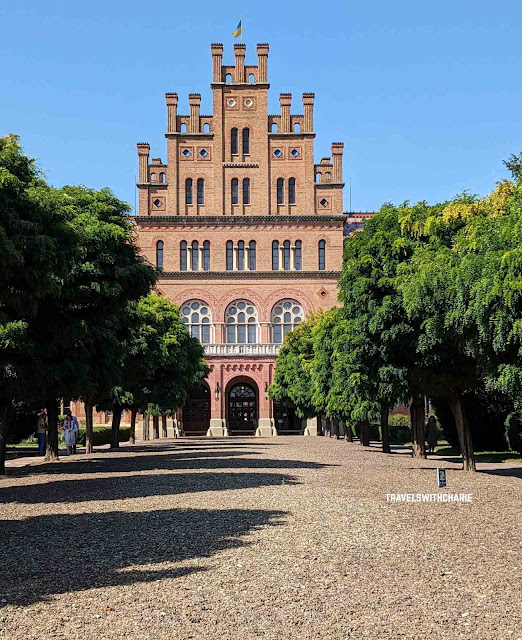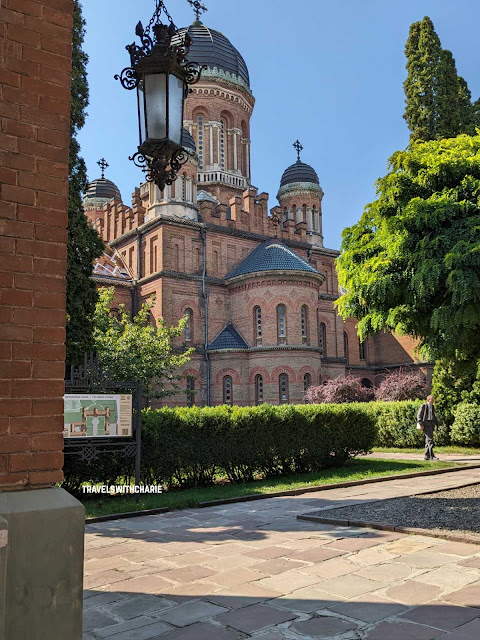Chernivtsi National University
When your country is at war but you live a thousand kilometers from the combat zones, how is your way of life affected? I had a surprisingly pleasant visit in Ukraine in September. There was no hint of the conflict happening on the eastern front. This is what I saw in Chernivtsi, a university town in Western Ukraine.
The Chernivtsi National University, once the residence of Bukovinian and Dalmatian Metropolitans (bishops), is a UNESCO World Heritage Site. The residence including the church, monastery and gardens incorporate Byzantine, Gothic and Baroque architectural styles. It became part of the University in 1955.
Bartka Outdoor Terrace
As soon as we arrived in Chernivtsi, we stopped for coffee, cola and cake at a rooftop café overlooking the city. How peaceful it was to sit there and soak in the view while slowly savoring my chocolate cake. Address: Holovna St., 124
There’s a lounge area outside the restrooms of the terrace café which it shares with the Nightclub on the fourth floor.
There was a wine fair on the ground floor below the café and we saw this unique Christmas tree made with bottles of wine. I wonder if they also start the Christmas season in September?
Praying at the beautiful Holy Spirit Orthodox Cathedral for an end to the war.
We saw two wedding parties at the university gate. The University with its beautiful grounds is a popular spot for photoshoots. It’s life as usual in Chernivtsi.
City Hall and Central Square
Beautiful Art Nouveau and Viennese architecture grace city streets.
We also found street art around the city.
Cinema formerly the Choral Temple
The Cinema was constructed in 1959 on the site of the Jewish Choral Temple which was built in 1877 and torched in the 1940s.
Olha Kobylianska Music and Drama Theater and Theater Square
Olha Kobylianska was a Ukrainian modernist writer and feminist. Among her novels are Tsarivna (Princess) and Arystokratka which were published in 1895 and 1896, respectively.
Sacred Heart of Jesus Roman Catholic Church, 1895
Had seafood lunch at Chernomorka Restaurant on Ștefan cel Mare și Sfint Boulevard and Olha Kobylianska pedestrian only street in the center of town. Food was good and surprisingly cheap. Lunch for two with drinks came to $24.00. I have to commend the excellent service. It was the best deal in all my travels in the Balkans.
The choices for lunch.
The highway to Chernivtsi is lined with trees and vast farmlands.
This is the queue of big rigs and tankers waiting to enter Ukraine. It’s about 9 km (5.6 miles) long.
Life goes on in Chernivtsi while in Kyiv, the capital of Ukraine, and other cities on the eastern side of the country, Ukrainians are living under constant threat of missile and drone attacks while sirens blare to warn them to seek cover. Before you go, find out about the security and safety situation in the country.
How to get there:
I was able to visit Chernivtsi as part of my private custom tour of Târgoviște, Bucovina, Western Ukraine and Moldova through Nicolas Experience Tours. If you wish to go on your own, check rome2rio.com for transportation options. If you are driving across the border from Romania or Poland, be aware of delays at the border and make sure you have your passport ready. US citizens may enter visa free and may stay up to 90 days within a 180-day period. For more information about entering Ukraine, follow this link: https://travel.state.gov/content/travel/en/international-travel/International-Travel-Country-Information-Pages/Ukraine.html
How to get around the city:
Trams and buses are the the best options for traveling outside the city center. The city center can be explored on foot.
Find Chernivtsi on the map:
*****
Images by TravelswithCharie




















